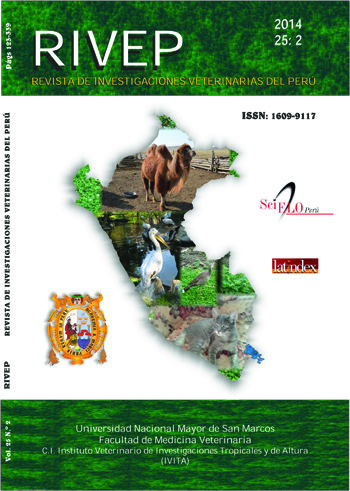HELMINTHIASIS IN ALPACAS (Vicugna pacos) OF TWO PEASANT COMMUNITIES IN MACUSANI, PUNO DURINGTHE DRY SEASON
DOI:
https://doi.org/10.15381/rivep.v25i2.8499Keywords:
alpaca, gastrointestinal parasites, Puno, dry seasonAbstract
The study aimed to estimate the prevalence of gastrointestinal helminth in alpacas oftwo peasant communities in Macusani district, Puno, Peru during the dry season and itsassociation with age and origin; also, to establish the average parasite burden and to identify the genus of helminth presents. Stool samples were collected from 1319 alpacasfrom August to October 2010 and were processed by the flotation method using Willissolution and by the spontaneous sedimentation technique. The parasite burden andidentification of nematode larvae was done by the McMaster method and the modifiedBaermann technique respectively. The prevalence of helminths was 63.9 ± 2.6%. Thelogistic regression test showed that age was a risk factor for the presence of helminths(p3 years old, while there wasno difference in the prevalence between the two communities. The parasite burden pereach genus was lower than 100 epg. Helminth genus identified were Nematodirus,Trichuris, Moniezia, Cooperia, Oesophagostomum, Trichostrongylus, Ostertagia,Bunostomum, Haemonchus, Capillaria and Lamanema, where the prevalence ofNematodirus spp was the highest (52.8%) followed by Trichuris spp (10.8%) and Monieziaspp (9.6%).Downloads
Downloads
Published
Issue
Section
License
Copyright (c) 2014 Nancy Contreras S., Amanda Chávez V., Rosa Pinedo V., Víctor Leyva V., Francisco Suárez A.

This work is licensed under a Creative Commons Attribution-NonCommercial-ShareAlike 4.0 International License.
AUTHORS RETAIN THEIR RIGHTS:
a. Authors retain their trade mark rights and patent, and also on any process or procedure described in the article.
b. Authors retain their right to share, copy, distribute, perform and publicly communicate their article (eg, to place their article in an institutional repository or publish it in a book), with an acknowledgment of its initial publication in the Revista de Investigaciones Veterinarias del Perú (RIVEP).
c. Authors retain theirs right to make a subsequent publication of their work, to use the article or any part thereof (eg a compilation of his papers, lecture notes, thesis, or a book), always indicating the source of publication (the originator of the work, journal, volume, number and date).










